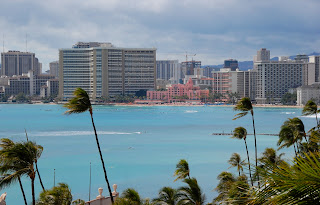 At 800 kilometers an hour - as fast as a commercial jetliner - the giant tsunami triggered by the biggest earthquake ever to hit Japan rolls across the Pacific towards the far reaches of South America, prompting mass evacuations and mass consternation, if not panic. The land masses and tiny atolls in its path can only brace for the worst and hope for the best, grateful for the huge investment made in tsunami warning systems after previous disasters.
At 800 kilometers an hour - as fast as a commercial jetliner - the giant tsunami triggered by the biggest earthquake ever to hit Japan rolls across the Pacific towards the far reaches of South America, prompting mass evacuations and mass consternation, if not panic. The land masses and tiny atolls in its path can only brace for the worst and hope for the best, grateful for the huge investment made in tsunami warning systems after previous disasters.The American-operated Pacific Tsunami Warning Center in Hawaii has a network of wave height monitoring gauges at key points across the world's biggest ocean. As preliminary results come in, the variations are dramatic, lower readings in some of the more vulnerable places, much higher ones in others, like the 2.2 metre ( 6.6 feet) surge recorded in Crescent City, California, the scene of a previous tsunami tragedy. As with everything else in this crisis, nature's display of wrath and unpredictability is awesome.
 |
| Tsunami surge: islet off Lautoka, Fiji |
Japan's economic domination of the Asia Pacific region may have been on the wane in recent years with a domestic slow-down and the rise of China and South Korea. But the body blow to Japanese infrastructure and confidence from this disaster will trigger a second economic tsunami throughout the region with just as much unpredictability as the physical one. Global markets fell as the extent of the disaster unfolded, traders - like everyone else - transfixed by the apocalyptic scenes on live television of whole towns swept away, burning oil refineries and a panic-stricken Japanese populace. It used to be said that when America sneezes, the whole world catches a cold. The Japanese contagion in our own region will be severe.
 |
| Vulnerable: Paradise until The Big One |
News of evacuations around one of the Japanese nuclear power stations after its cooling system failed can only add to the doomsday gloom. What happens below ground has, of course, nothing to do with global warming. But it has huge potential to throttle wider adoption of the one viable technology the world has right now to generate power without the carbon emissions being blamed for that warming in many quarters. If nuclear power isn't safe not because of technology but "terra infirma", then the case for adopting it is naturally weaker. It'll be a sobering irony for everyone if the place where the nuclear weapon was first used becomes the burial ground for nuclear power.

The Pacific Ring of Fire you talk about is where three continental shelves rub up against each other. There's no way to prevent these quakes and no-one can say for sure when they'll strike. The urban sprawl around Tokyo is one of the most vulnerable areas in the whole Pacific. That Kanto Plain is home to one of densest population concentrations in the Asia Pacific. And, yes, the experts say "the big one" is due anytime within the next 30 years. That means anyone living in Tokyo is playing Russian roulette. It's even more stupid to have nuclear facilities sitting on that Ring of Fire. If this quake has caused a nuclear incident, imagine what might happen in a bigger disaster? Very worrying on every front.
ReplyDelete